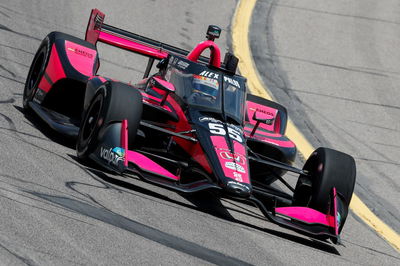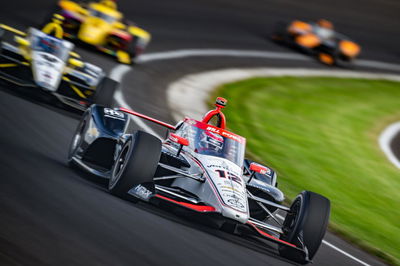How Super Formula was a key stepping stone in Alex Palou’s path to IndyCar stardom
With three itles in the last four years and 13 race victories, Alex Palou is the driver to beat in IndyCar this season. But his talent may have never been recognised had he not received a chance to show his skills in Japan.

Alex Palou’s rise to stardom in IndyCar has been so exceptional that it is easy to forget that his results in junior formula weren’t actually that remarkable - but not due to a lack of speed.
Growing up in his native Spain, Palou gradually moved up the ladder in the European racing scene, reaching the GP3 series in 2015-16. But while he was quick behind the wheel, and even scored a victory in Abu Dhabi at the end of his rookie season, the midfield Campos team made him look rather average compared to future Formula 1 drivers Alex Albon and Charles Leclerc, who were racing for the plum ART team.
It wasn’t until he stepped up to Japan’s underrated Super Formula champion in 2019 that his raw pace started translating into actual results.
Super Formula had been on Palou’s radar for some time, having already contested the Japanese Formula 3 championship in 2017 and finished third behind Mitsunori Takaboshi and Sho Tsuboi in his rookie season.
But there were simply no seats on the Super Formula grid in 2018 and he had to spend a year in the European Formula 3 series on the DTM support bill before finally getting his big shot in Japan’s biggest single-seater series the following year.
Honda placed Palou at Nakajima Racing, the eponymous squad run by former Formula 1 driver Satoru Nakajima. The team’s results in previous years had been quite underwhelming, but the field was levelled up by the introduction of a brand new Dallara chassis in 2019.
It didn’t take much time for the Spaniard to adapt to the new and faster SF19, as he broke the unofficial lap record at Suzuka on the first day of testing. A front-row start in the season opener at the same track showed his testing pace was no fluke; he was genuinely going to be a frontrunner in his rookie season.
The race didn’t quite go his way, with a wheel failure sending him into retirement, but the DNF didn’t dampen Palou’s spirits whatsoever.
He scored his first points of the year next time out at Autopolis and would have also finished inside the top 10 in Sugo if it wasn’t a penalty.
Then came Fuj, where Palou upped his ante and marked himself out as a serious championship contender with a brilliant wet-weather drive. Having scored his maiden pole position just a day before on a sodden track, the Spaniard again mastered the treacherous conditions in the race to lead every single lap from pole position. Palou’s final winning margin was 13 seconds in what was an incredible display of his class.
If you have to pick one race from Palou’s entire junior career to rewatch, it has to be this one - this was a perfect example of a driver being completely in one with the car and annihilating the competition like they are in a different category altogether.

Palou followed his maiden win with a pair of fourth-place finishes at Motegi and Okayama to keep himself in the championship hunt heading into the season finale at Suzuka. Just four points separated him and standings leader Naoki Yamamoto, with Nick Cassidy also in the fight with them.
No driver since Ralf Schumacher in 1996 had won a Super Formula title in his rookie season, but if someone could repeat that feat, it seemed like it would be Palou.
Palou made the first step towards his title bid by taking pole position on Saturday, and with it the bonus point that narrowed the gap further to Dandelion rival Yamamoto.
When the race began on Sunday, he pulled away cleanly from pole position and didn’t put a foot wrong in the first stint. But much like the season opener at Suzuka, luck wasn’t simply not on his side on the series' return to the Japanese GP venue. A loose intercooler pipe got stuck in the rear suspension of his car just before his mandatory stop, costing him a heap of time while also wearing out his tyres.
The Spaniard was left with no option but to make a second, unscheduled pitstop, which dropped him further down the order. In the end, he crossed the finish line in a distant 19th place, only ahead of a lapped Harrison Newey.
Palou’s misery allowed Cassidy to claim his first Super Formula title for the Toyota-powered TOM’S team, but the then-22-year-old took the defeat rather magnanimously.
Stressing that the mechanical failure was neither his fault nor his team’s, Palou was more than content to have challenged for the title in his maiden season in Super Formula and eventually finished a solid third in the standings.
It’s worth highlighting that he played a key role in the resurgence of Nakajima Racing, a team that had finished eighth and the lowest among the two-car squads just the previous season with the SF14.
The IndyCar switch

At the end of the year, Palou had the option of remaining with Honda in Japan or joining a rival like Nissan and Toyota/Lexus. Palou’s brilliant first year in Super Formula hadn’t gone unnoticed and all three Japanese brands were keen to secure his services in 2020.
This would have given Palou a second crack at the Super Formula title, while potentially stepping up to SUPER GT’s top GT500 category as a factory driver. Already in 2019, he had raced a McLaren 720S GT3 in the GT300 class with the returning Team Goh squad alongside his primary commitments in Super Formula with Nakajima Racing and Honda.
However, late in November, a seat unexpectedly opened up in IndyCar after Dale Coyne Racing split with four-time Champ Car title-winner Sebastien Bourdais.
Team boss Dale Coyne had been eager to sign Palou ever since he did a private test for DCR at Mid-Ohio in July of that year, and he was not going to miss this chance.
Palou was already eight tenths quicker than former Formula 1 driver Felipe Nasr in his first try-out in IndyCar machinery, and Coyne knew that he had found a huge star-in-the-making.
An agreement was reached for Palou to leave Japan to head stateside, with backing from Kazumichi Goh helping get the deal over the line.
Palou’s move received the blessing of Honda, which happened to be the engine supplier for DCR in IndyCar.
In a year in which in-season testing was outlawed and weekend running was limited due to the pandemic, Palou performed admirably in IndyCar, scoring a podium at Road America to finish second among the rookies.
But it was his move to another Honda-powered squad Chip Ganassi Racing in 2021 that transformed his fortunes, and the rest as they say is history.










